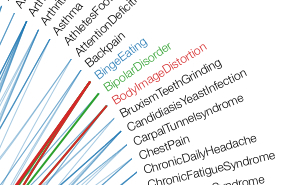 Click on the image above for the interactive visualization.
Click on the image above for the interactive visualization.
Some things just go together – peanut butter and jelly, cheese and crackers, Tango and Cash. Other things not so much, or, at least, not until you dig into the connections a little deeper.
In health, the connection between two or more health conditions is often intuitive. If you grind your teeth, it stands to reason that you would have pain symptoms around the jaw. It makes sense that a person who has eczema might also have other skin conditions like dandruff or psoriasis.
But the connection between other health conditions isn’t always so obvious. Digging into those connections, finding out if they are real, and, if they are real, why they might be related, can tell us a lot of about disease.
With that in mind, we’ve created a visualization of several dozen self-reported health conditions from more than 38,000 members of CureTogether, which 23andMe acquired in early July. CureTogether is a free resource for people to share information about diseases and treatments. This kind of data can be helpful to both members interested in comparing their own health issues with others, and researchers looking for a deeper understanding of illnesses.

“(It) can give insights into the underlying biology of the conditions,” said Emily Chang, a scientist on 23andMe’s Science Content and Curation Team. “Perhaps there are genetic factors or environmental factors that predispose a person to both conditions.”
One condition might be a symptom of the other, but whatever the connection, exploring why two or more conditions might be related is essential.
“Accurate knowledge of a condition’s symptoms can aid biological understanding and improve diagnosis,” Emily said.
Daniel Reda, CureTogether’s co-founder and now a 23andMe Senior Product Manager worked with Emily to create the visualization. The two compiled more than 4.4 million points of data to show conditions and symptoms that have a statistically strong connection to each other.
“As we accumulate more data, we can replicate this type of analysis and this should help reveal which of the associations may be spurious and which are probably real,” said Daniel.
What Daniel and Emily have created is a sort of Wheel of Conditions. It shows connections between different conditions, diseases, and symptoms. Selecting a condition will highlight other conditions that are most likely to occur in common.
What you’ll see very quickly is that some of the connections, as we’ve said, just go together. Others, at first blush, may make you scratch your head, but digging a little may help explain the connection.
For example, why would anemia have a connection with infertility?
“(It) makes intuitive sense to me from an evolutionary perspective,” said Daniel. “The body would want to avoid the huge energy investment of pregnancy if the blood has potentially insufficient oxygen-carrying capacity. In ancestral times, vitamin deficiency from food scarcity would have caused anemia, so it would make sense for the body to be able to turn off its reproductive potential until conditions improved.”
The wheel also shows some conditions, fibromyalgia, for instance, are hubs for many others.
![]()
Not yet a customer? Visit our store!
Emily suggests that in some cases a condition may have a broad range of symptoms – pain, depression or fatigue – accounting for multiple connections.
“A large number of causes, the large number of symptoms and the difficulty in accurately diagnosing the conditions probably all contribute to many connections between these conditions and others on the chart,” she said.
What’s exciting is that this is just a first step. Integrating 23andMe’s genotypic and phenotypic data may be able to reveal a deeper understanding of the causes of these conditions.
“Hopefully, (it will) lead to more insights,” Emily said. “With a larger database we will be able to be more accurate making connections and also will be able to make more connections. Genotypic information can add still more.”
Combining genetic and phenotype data from these two large data promises to bring new understanding to disease.